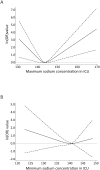The association between intensive care unit-acquired hypernatraemia and mortality in critically ill patients with cerebrovascular diseases: a single-centre cohort study in Japan
- PMID: 28821524
- PMCID: PMC5629676
- DOI: 10.1136/bmjopen-2017-016248
The association between intensive care unit-acquired hypernatraemia and mortality in critically ill patients with cerebrovascular diseases: a single-centre cohort study in Japan
Abstract
Objectives: Hypernatraemia is one of the major electrolyte disorders associated with mortality among critically ill patients in intensive care units (ICUs). It is unclear whether this applies to patients with cerebrovascular diseases in whom high sodium concentrations may be allowed in order to prevent cerebral oedema. This study aimed to examine the association between ICU-acquired hypernatraemia and the prognosis of patients with cerebrovascular diseases.
Design: A retrospective cohort study.
Setting: The incidence of ICU-acquired hypernatraemia was assessed retrospectively in a single tertiary care facility in Japan.
Participants: Adult patients (≥18 years old) whose length of stay in ICU was >2 days and those whose serum sodium concentrations were 130-149 mEq/L on admission to ICU were included.
Outcome measures: 28-day in-hospital mortality risk was assessed by Cox regression analysis. Hypernatraemia was defined as serum sodium concentration ≥150 mEq/L. Using multivariate analysis, we examined whether ICU-acquired hypernatraemia and the main symptom present at ICU admission were associated with time to death among ICU patients. We also evaluated how the maximum and minimum sodium concentrations during ICU stay were associated with mortality, using restricted cubic splines.
Results: Of 1756 patients, 121 developed ICU-acquired hypernatraemia. Multivariate Cox proportional hazard analysis revealed an association between ICU-acquired hypernatraemia and 28-day mortality (adjusted HR, 3.07 (95% CI 2.12 to 4.44)). The interaction between ICU-acquired hypernatraemia and cerebrovascular disease was significantly associated with 28-day mortality (HR, 3.03 (95% CI 1.29 to 7.15)). The restricted cubic splines analysis of maximum serum sodium concentration in ICU patients determined a threshold maximum of 147 mEq/L. There was no significant association between minimum sodium concentration and mortality.
Conclusions: ICU-acquired hypernatraemia was associated with an increased mortality rate among critically ill patients with cerebrovascular diseases; the threshold maximum serum sodium concentration associated with mortality was 147 mEq/L.
Keywords: cerebrovascular disease; epidemiology; hypernatraemia; intensive care unit; restricted cubic spline.
© Article author(s) (or their employer(s) unless otherwise stated in the text of the article) 2017. All rights reserved. No commercial use is permitted unless otherwise expressly granted.
Conflict of interest statement
Competing interests: The Department of Nephrology, Nagoya University Graduate School of Medicine, received research promotion grants from Astellas, Alexion, Otsuka, Kyowa Hakko Kirin, Daiichi Sankyo, Dainippon Sumitomo, Takeda, Torii, Pfizer and Mochida. The Department of Nephrology, Toyohashi Municipal Hospital, received research grants from Kyowa Hakko Kirin, Otsuka, Chugai, Astellas, Takeda, Torii and Asahikasei. The Center for Advanced Medicine and Clinical Research, Nagoya University Hospital and Chubu Rosai Hospital received no research grants or donations.
Figures



References
MeSH terms
Substances
LinkOut - more resources
Full Text Sources
Other Literature Sources
Medical
Molecular Biology Databases
